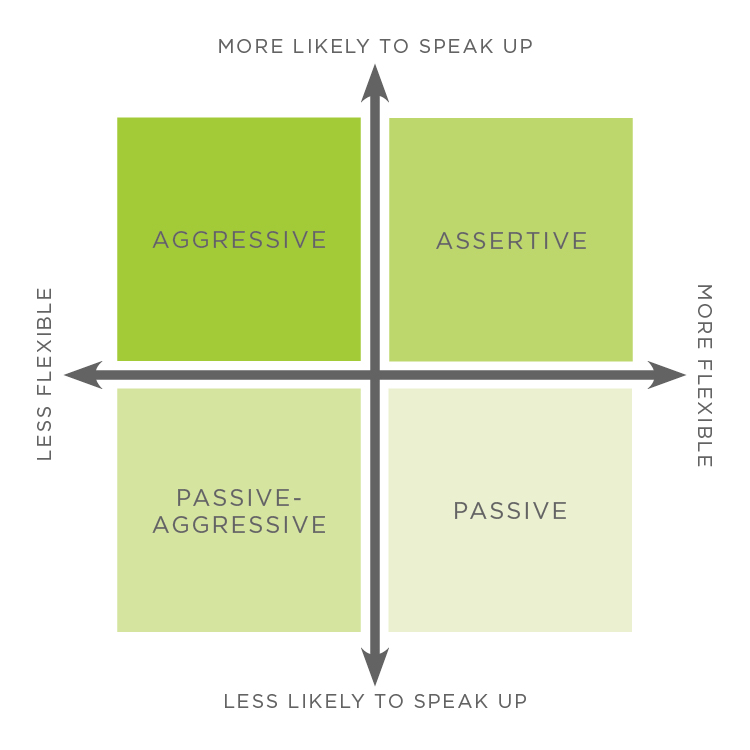My co-worker used a slight tone in the staff meeting, are they angry at me? Why doesn’t Sally ever voice her opinions? Josie said she was “fine,” but I just heard her gossiping behind my back. We’ve all been there: Different forms of communication and tone lead to a storm of misinterpretation, wrongfully perceived anger and sometimes hurt feelings. It’s frustrating to not grasp the why behind someone’s tone, or lack of tone thereof. Yet, we all have a communication style that we bring to the workplace. Your colleague who might seem resentful or even hostile to you could see nothing strange with how they’re speaking. Having a mish mash of different styles brings confusion or conflict in the workplace. It’s important to understand each distinct communication style and how to blend these styles together for a more harmonious environment.
Research on communication indicates four distinct communication styles:
- Passive Communication: Often a lack of communication, likely driven by fear of speaking up.
- Aggressive Communication: Frequently fueled by anger and judgment, which often leads to hostility or inflexibility.
- Passive-Aggressive Communication: No direct communication of feelings, but communication tends to be influenced by negative emotions.
- Assertive Communication: Respectful, honest and confident in expressing opinions or feelings.
It’s common to manifest more than one communication style depending on your environment; however, it’s important to understand each style’s nuances and how they affect a team. There are multiple factors that could influence someone’s communication: cultural and social conventions, societal norms or gender roles, emotions/perception, or environment. This also impacts how you might perceive communication too. Someone who tends to be more passive might interpret assertive communication as actually being aggressive. This can lead to misunderstandings or closed doors to tough conversations.

Working with Each Style
Passive Style
A passive communicator might be quick to apologize or blame themselves harshly for every little mistake. They’re also unlikely to truly voice their opinions in a group setting — this doesn’t mean they don’t have thoughts, though. Let’s say your team has had a higher volume of work than usual. A passive communicator is unlikely to complain — instead, they might work extra hours to complete their tasks without raising the issue.
One-on-one conversations that provide a safe space give these communicators the opportunity to share their feedback. They might not offer their thoughts in a group meeting for fear of ridicule. Instead, implement frequent check-ins or one-on-one meetings to glean their ideas or opinions. Stay optimistic and use an encouraging tone during these meetings.
Aggressive Style
The word “aggressive” often has a negative tone, but research shows that these communicators actually don’t intend to come off negatively. They’re confident and direct, which can often show itself through interrupting colleagues, not fully taking responsibility for mistakes or overshadowing others. In the situation of a high work volume, an aggressive communicator might call out management about the workload directly in a meeting, stating that they can’t handle it. When working with an aggressive communicator, remain calm and direct, avoid emotionally charged language, and use conflict management if needed.
Passive-Aggressive Style
This communicator might seem passive, but they could be hiding negative or aggressive thoughts below the surface. They’ll often avoid conflict with leadership but talk negatively with colleagues instead. If they experience too much work, they’re unlikely to address leadership specifically, but they’ll likely complain to other coworkers.
Nonverbal body language can provide managers with cues on how this communicator is actually feeling. Using humor or kindness can help these colleagues to open up more freely, but you’ll want to stay on top of gossip and confront negative behavior. Directly ask these communicators to give feedback on specific problems or situations. Stay positive and provide clear directions.
Assertive Style
Similar to an aggressive communicator, an assertive team member is confident and able to express their needs. They often open the door for tough conversations and will speak their mind. When dealing with too much work, they’re more likely to address the issue one-on-one with their manager, citing that they don’t have the bandwidth to take on more tasks and offer solutions for redistributing the work. As a manager, you’ll want to ensure these communicators still feel valued and encouraged, despite them speaking up with their concerns. Implement one-on-one meetings, in which you lift up their work while providing an opportunity for their feedback.
Additional Tips
Different communication styles can thrive in different roles. Aggressive and assertive communicators are more likely to take charge in situations, while someone who is more passive is great at problem solving and working behind the scenes. As a leader, it’s important to discern each team member’s style and how those styles can work best in your company. There are quizzes online you can have employees take, or you can often figure out communication styles by observing how your team members react in certain situations, keeping an eye out for their tone and body language. To avoid miscommunication — especially digitally — avoid “you” language, as this can apply blame to the other person; consider your punctuation and avoid the use of all-caps, which can suggest anger; ask questions for clarity; and remember that your tone is everything.
Sources
www.indeed.com
www.snhu.edu
Jessica Sears is senior writer at Innovative Publishing. She can be reached at jessica@innovativepublishing.com.


Comments are closed.